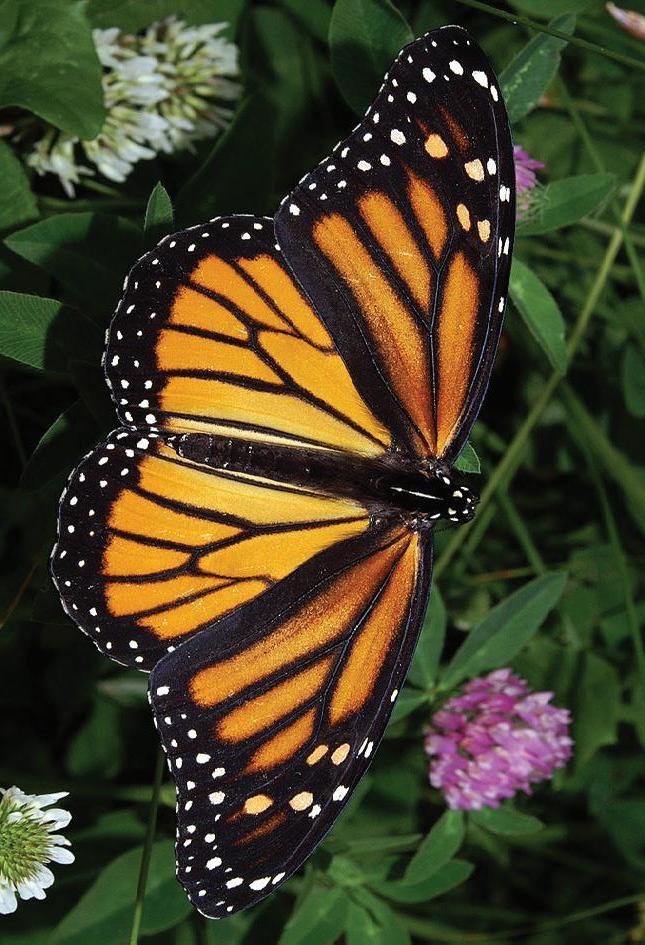
3 minute read
Kids’ Planet
Kids’ Planet... with Thorne Nature Experience
Drawing by Kara Priest
Advertisement

by Dr. Oakleigh Thorne, II
Many years ago, when I was starting to make educational films, I made one called Orders of Insects. Insects are members of the class Insecta, but different kinds of insects are grouped together. These groups are called orders. Most insects have three body parts: head, thorax (middle part), and abdomen (rear part). Most have two pairs of wings, that is, four wings with two on each side.
For example, one order (or group) includes grasshoppers, locusts, and katydids. These insects have straight wings and many of them prefer to hop rather than fly. They have chewing mouth parts, as every gardener knows when grasshoppers eat the leaves in their garden!
Another well-known order of insects includes butterflies and moths. The monarch butterfly is one of my favorites. It seems to be in danger now because we don’t see as many as we used to, possibly due to loss of some of its habitats (places where it lives) due to destruction by humans. Moths are more active at night. I’m sure you have seen how moths are attracted to streetlights or your porch light at night.
ORDERS OF INSECTS
Photo by Kenneth Dwain Harrelson, CC BY-SA 3.0, https://commons.wikimedia.org/w/index.php?curid=14917505

The monarch butterfly or simply monarch (Danaus plexippus) is a milkweed butterfly (subfamily Danainae) in the family Nymphalidae
Beetles are a well-known order of insects. Probably the most famous is the ladybird beetle, which we often refer to as a ladybug; but it is not a bug, it’s a beetle. Beetles have their front pair of wings modified into a hard cover. If you’ve ever watched a ladybird get ready to fly, it opens the hard shell front wings and extends its membranous (membranelike) hind wings with which it then flies.
True bugs are members of the order Hemiptera. Hemi means “half” and ptera means “wing.” In true bugs, the front wings are thick and leathery nearest their body and thinner and membranous toward the tips. When they fold these wings, it forms an upside-down V. The best example that we have around here is the boxelder bug where the V is orangecolored compared to the black wing color.
Another order of insects is the Homoptera, which means “whole-wings.” The best example is the cicada. Its wings are completely clear and membranous, so you can see through them.
My favorite order includes dragonflies and damselflies. Dragonflies have four clear, membranous wings that stick straight out both when flying and at rest. They eat (prey on) smaller insects like mosquitoes and gnats. Damselflies are smaller than dragonflies and when at rest, they fold their wings straight over their abdomens. Dragonflies are symbols of good luck in Asian countries. My daughter uses the dragonfly as trademark for her Science Kids program in northern Wyoming where she takes kids outdoors on nature field trips.
Diptera means “two wings” and this order includes flies, mosquitoes, gnats, and midges. This is the only order of insects that has just two wings (one pair). We all know the common housefly and we often use insect repellent to keep mosquitoes from biting us in the summertime. We usually don’t see any insects during the winter, but on a warm winter day, guess which of the insects we usually can always see: flies!
The last order of insects that I want to mention includes bees, wasps, hornets and yellow-jackets. Of all of these, honeybees are probably the most important. They give us honey and they pollinate flowers and other blossoms.
A person who studies insects is called an entomologist. Maybe you
will become one someday! There are more insects in the world than any other animal. They are pretty fascinating to study!
Dr. Thorne is founder and president of Thorne Nature Experience (formerly Thorne Ecological Institute), a nonprofit organization headquartered in Boulder. For 66 years they have helped “connect youth to nature!” For information about their programs, please check their website at www. thornenature.org or email info@ thornenature.org or call (303) 4993647, ext. 100.



CARL JUNG

BOULDER 3000 CENTER GREEN DRIVE
FAMILY OWNED AND OPERATED SINCE 1989










